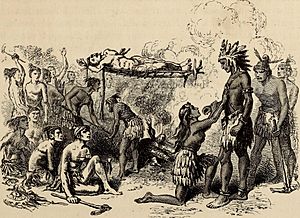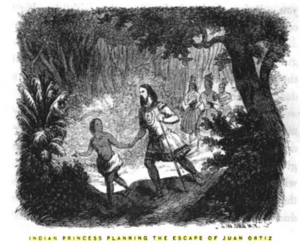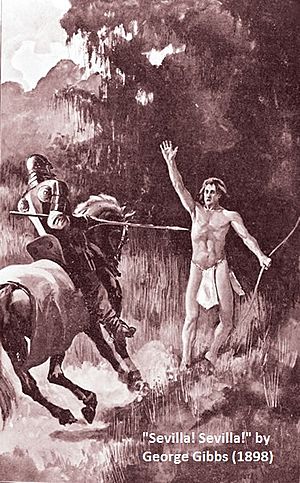Juan Ortiz (captive) facts for kids
Juan Ortiz was a Spanish sailor who was held captive by Native Americans in Florida for eleven years, from 1528 until he was rescued by the Hernando de Soto expedition in 1539. Two accounts of Ortiz's eleven years as a captive, differing in details, offer a story of Ortiz being sentenced to death by a Native American chief two or three times, saved each time by the intervention of a daughter (and possibly other female relatives) of the chief, and finally escaping to a neighboring chiefdom, whose chief sheltered him.
Captivity
In 1528 Juan Ortiz was on a ship searching Tampa Bay for any sign of the Narváez expedition which had landed in Tampa Bay the year before. Ortiz and one or more companions were enticed on shore by some people who had what the Spanish thought was a message from Narváez. (The Spanish would not learn the fate of the Narváez expedition for another eight years, until Álvar Núñez Cabeza de Vaca and three other survivors reached a Spanish outpost in northwestern New Spain.) Ortiz and his companions were captured by the people on shore and abandoned by their shipmates. All but Ortiz were either killed while resisting capture or shortly after being taken to the town of Uzita. After Ortiz was taken to the town of Uzita (as told by the Gentleman of Elvas), or some time after Ortiz was spared from execution by being shot with arrows (per the Inca), the chief ordered Ortiz tied to a rack set over a fire. The chief's daughter begged the chief to spare Ortiz, arguing that Ortiz was not a danger to the chief.
After Ortiz's burns had been tended to, he was set to guard bodies placed in the charnel house of the town, to keep predators from taking the bodies away during the night. One night a wolf took the body of a young child that had recently died. Ortiz pursued the wolf in the night and killed it, recovering the child's body. The chief Uzita treated Ortiz better for a while after that.
Two or three years after Ortiz had been captured, the chiefdom of Mocoso attacked Uzita, burning the town. The town of Uzita was then moved to a new location, and the chiefdom's gods demanded that Ortiz be sacrificed. The daughter of Chief Uzita warned Ortiz that he was to be sacrificed and told him he should go to Mocoso, whose chief had asked for Ortiz to be given to him. The daughter led Ortiz out of the town at night, and showed him the path to Mocoso.
Rescue and after
Juan Ortiz was found by the de Soto Expedition when they landed in Tampa Bay in 1539. After first landing at Uzita, de Soto and his men heard of a Christian living in a neighboring chiefdom. While searching for Ortiz, de Soto's men encountered ten or so Native Americans, and started to attack them. Ortiz was with the group being attacked, but he managed to make the Spanish understand that he was a Christian (one account says he did so by calling out "Sevilla", which was his home town). Ortiz then led the Spanish to the town of Mocoso, whose chief, also named Mocoso, had sheltered him for many years. Mocoso was friendly to de Soto, which created tension between Mocoso and other chiefdoms around Tampa Bay, including Orriygua, Neguarete, Capaloey and Uzita.
Ortiz could speak the languages of both Uzita and Mocoso (which were mutually unintelligible). The language of Mocoso was apparently a dialect of the Timucua language, which made Ortiz very useful to de Soto. As the expedition traveled up the Florida peninsula, it passed through chiefdoms that spoke various dialects of the Timucua language, until the expedition crossed the Aucilla River, and entered the Apalachee Province. From that point the expedition relied on Timucua speakers who could translate from other languages, with Ortiz then providing a translation into Spanish.
Juan Ortiz died sometime during the winter of 1541–1542, while the expedition was camped at the town of Autiamque in what is now Arkansas.
Legend
The Inca's version of the story of Juan Ortiz and the daughter of Chief Hirrihigua has grown into a legend. The daughter of a chief has become "Princess Hirrihigua", and in some versions has acquired a name, "Uleleh". The Princess Hirrihigua Chapter of the Daughters of the American Revolution erected a marker in St. Petersburg, Florida, commemorating the story of Juan Ortiz and Princess Hirrihigua in 1960. A longer version of this legend, with the addition of the name "Uleleh", "The Story of Juan Ortiz and Uleleh", was published by a historical society in 1908.
John Smith and Pocahontas
Some scholars have speculated that John Smith's story of being saved from death at the hands of Powhatan by his daughter Pocahontas was inspired by the story of Juan Ortiz being saved by the daughter of Chief Uzita. Richard Hakluyt's translation into English of A Narrative of the Expedition of Ferdinand de Soto into Florida by the Gentleman of Elvas was published in London in 1609, several years before John Smith published his account of being saved by Pocahontas.
See also
 In Spanish: Juan Ortiz (cautivo) para niños
In Spanish: Juan Ortiz (cautivo) para niños




